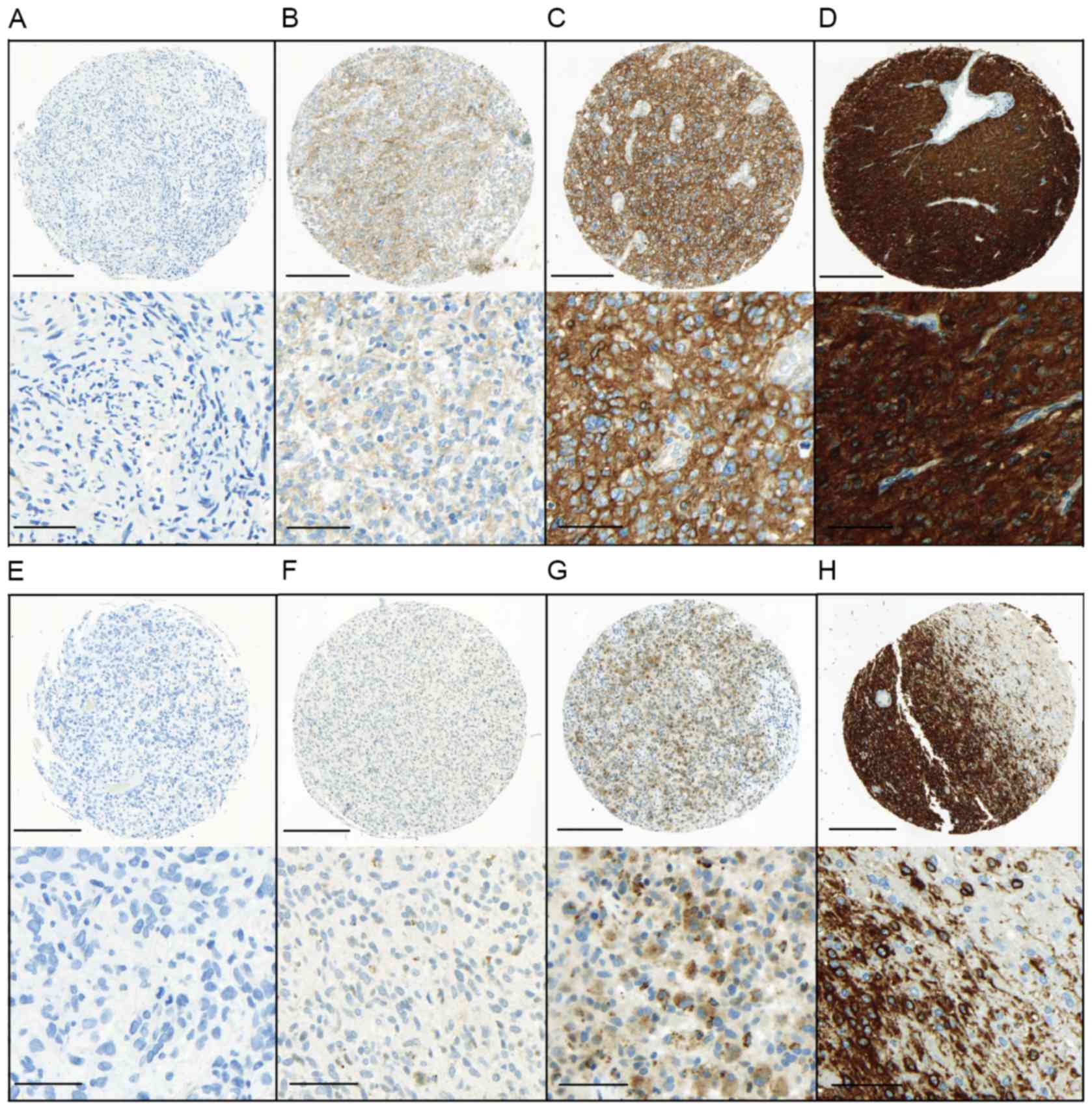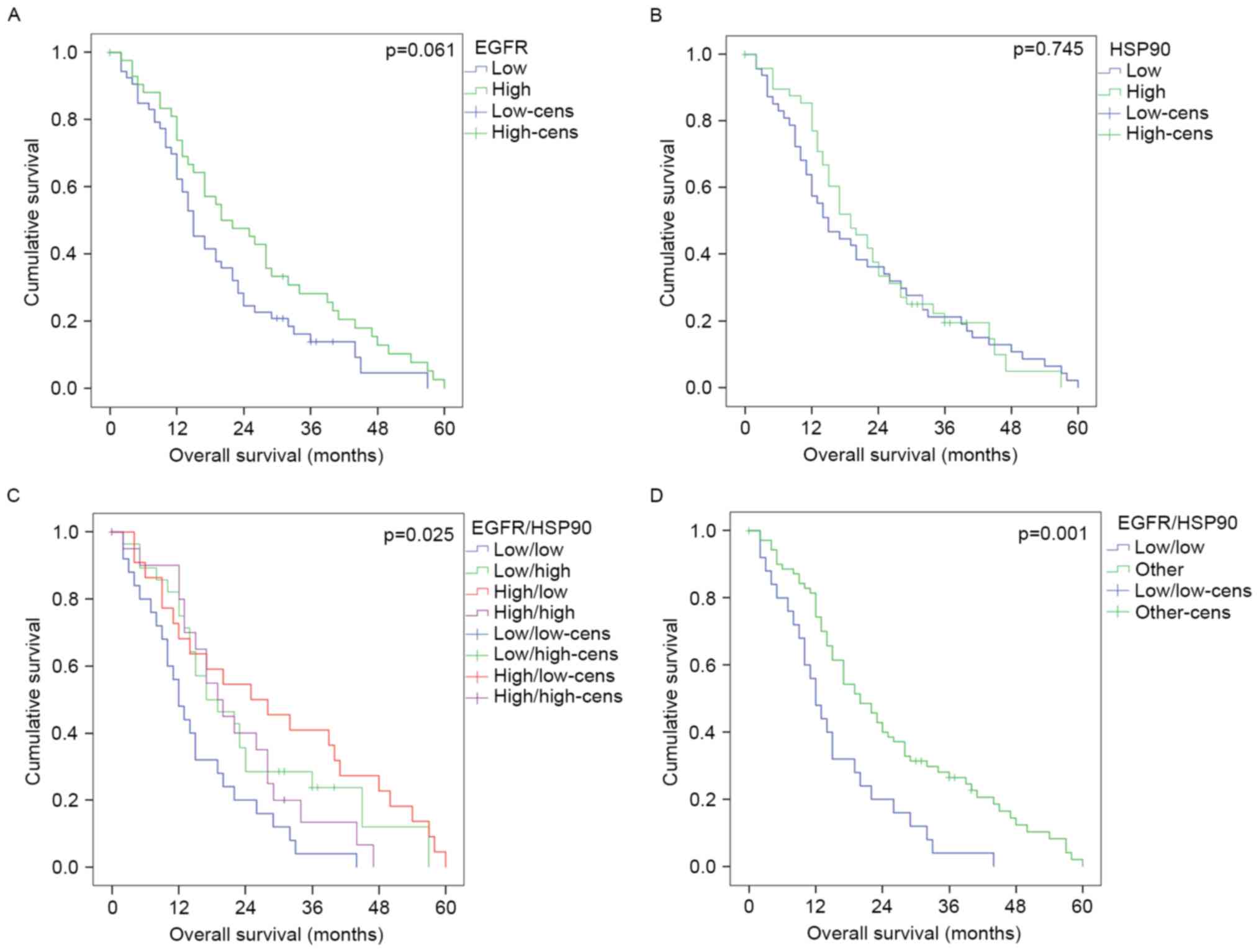|
1
|
Louis DN, Suvà ML, Burger PC, Perry A,
Kleihues P, Aldape KD, Brat DJ, Biernat W, Bigner DD, Nakazato Y,
et al: Glioblastoma, IDH-wildtype. In: WHO Classification of
Tumours of the Central Nervous System4th. Louis DN, Ohgaki H,
Wiestler OD and Cavenee WK: International Agency for the Research
on Cancer. Lyon: pp. 28–45. 2016
|
|
2
|
Ostrom QT, Gittleman H, Fulop J, Liu M,
Blanda R, Kromer C, Wolinsky Y, Kruchko C and Barnholtz-Sloan JS:
CBTRUS statistical report: Primary brain and central nervous system
tumors diagnosed in the United States in 2008–2012. Neuro Oncol. 17
Suppl 4:iv1–iv62. 2015. View Article : Google Scholar : PubMed/NCBI
|
|
3
|
Aldape K, Zadeh G, Mansouri S,
Reifenberger G and von Deimling A: Glioblastoma: Pathology,
molecular mechanisms and markers. Acta Neuropathol. 129:829–848.
2015. View Article : Google Scholar : PubMed/NCBI
|
|
4
|
Ohgaki H and Kleihues P: The definition of
primary and secondary glioblastoma. Clin Cancer Res. 19:764–772.
2013. View Article : Google Scholar : PubMed/NCBI
|
|
5
|
Hartmann C, Hentschel B, Wick W, Capper D,
Felsberg J, Simon M, Westphal M, Schackert G, Meyermann R, Pietsch
T, et al: Patients with IDH1 wild-type anaplastic
astrocytomas exhibit worse prognosis than IDH1-mutated
glioblastomas, and IDH1 mutation status accounts for the
unfavorable prognostic effect of higher age: Implications for
classification of gliomas. Acta Neuropathol. 120:707–718. 2010.
View Article : Google Scholar : PubMed/NCBI
|
|
6
|
Capper D, Weissert S, Balss J, Habel A,
Meyer J, Jäger D, Ackermann U, Tessmer C, Korshunov A, Zentgraf H,
et al: Characterization of R132H mutation-specific IDH1 antibody
binding in brain tumors. Brain Pathol. 20:245–254. 2010. View Article : Google Scholar : PubMed/NCBI
|
|
7
|
Ke EE and Wu YL: EGFR as a pharmacological
target in EGFR-mutant non-small-cell lung cancer: Where do
we stand now? Trends Pharmacol Sci. 37:887–903. 2016. View Article : Google Scholar : PubMed/NCBI
|
|
8
|
Wells A: EGF receptor. Int J Biochem Cell
Biol. 31:637–643. 1999. View Article : Google Scholar : PubMed/NCBI
|
|
9
|
Ohgaki H, Dessen P, Jourde B, Horstmann S,
Nishikawa T, Di Patre PL, Burkhard C, Schüler D, Probst-Hensch NM,
Maiorka PC, et al: Genetic pathways to glioblastoma: A
population-based study. Cancer Res. 64:6892–6899. 2004. View Article : Google Scholar : PubMed/NCBI
|
|
10
|
Roskoski R Jr: ErbB/HER protein-tyrosine
kinases: Structures and small molecule inhibitors. Pharmacol Res.
87:42–59. 2014. View Article : Google Scholar : PubMed/NCBI
|
|
11
|
Padfield E, Ellis HP and Kurian KM:
Current therapeutic advances targeting EGFR and EGFRvIII in
glioblastoma. Front Oncol. 5:52015. View Article : Google Scholar : PubMed/NCBI
|
|
12
|
Whitesell L and Lindquist SL: HSP90 and
the chaperoning of cancer. Nat Rev Cancer. 5:761–772. 2005.
View Article : Google Scholar : PubMed/NCBI
|
|
13
|
Calderwood SK and Gong J: Heat shock
proteins promote cancer: It's a protection racket. Trends Biochem
Sci. 41:311–323. 2016. View Article : Google Scholar : PubMed/NCBI
|
|
14
|
Combs SE, Schmid TE, Vaupel P and Multhoff
G: Stress response leading to resistance in glioblastoma-the need
for innovative radiotherapy (iRT) concepts. Cancers. 8:82016.
View Article : Google Scholar :
|
|
15
|
van Ommeren R, Staudt MD, Xu H and Hebb
MO: Advances in HSP27 and HSP90-targeting strategies for
glioblastoma. J Neuro Oncol. 127:209–219. 2016. View Article : Google Scholar
|
|
16
|
Sartori E: Zusammenstellung eines
Patienten- und Gewebekollektivs für die Untersuchung von Heat Shock
Proteinen und ErbB Rezeptoren in Glioblastomen. Master Thesis.
1–25. 2015.
|
|
17
|
McShane LM, Altman DG, Sauerbrei W, Taube
SE, Gion M and Clark GM: Statistics Subcommittee of the NCI-EORTC
Working Group on Cancer Diagnostics: Reporting recommendations for
tumor marker prognostic studies. J Clin Oncol. 23:9067–9072. 2005.
View Article : Google Scholar : PubMed/NCBI
|
|
18
|
Altman DG, McShane LM, Sauerbrei W and
Taube SE: Reporting Recommendations for Tumor Marker Prognostic
Studies (REMARK): Explanation and elaboration. PLoS Med.
9:e10012162012. View Article : Google Scholar : PubMed/NCBI
|
|
19
|
Zlobec I, Koelzer VH, Dawson H, Perren A
and Lugli A: Next-generation tissue microarray (ngTMA) increases
the quality of biomarker studies: An example using CD3, CD8, and
CD45RO in the tumor microenvironment of six different solid tumor
types. J Transl Med. 11:1042013. View Article : Google Scholar : PubMed/NCBI
|
|
20
|
Guillaudeau A, Durand K, Pommepuy I,
Robert S, Chaunavel A, Lacorre S, DeArmas R, Bourtoumieux S, El
Demery M, Moreau JJ, et al: Determination of EGFR status in
gliomas: Usefulness of immunohistochemistry and fluorescent in situ
hybridization. Appl Immunohistochem Mol Morphol. 17:220–226. 2009.
View Article : Google Scholar : PubMed/NCBI
|
|
21
|
Siegelin MD, Habel A and Gaiser T: 17-AAG
sensitized malignant glioma cells to death-receptor mediated
apoptosis. Neurobiol Dis. 33:243–249. 2009. View Article : Google Scholar : PubMed/NCBI
|
|
22
|
Hewer E, Beck J, Murek M, Kappeler A,
Vassella E and Vajtai I: Polymorphous oligodendroglioma of Zülch
revisited: A genetically heterogeneous group of anaplastic gliomas
including tumors of bona fide oligodendroglial differentiation.
Neuropathology. 34:323–332. 2014.PubMed/NCBI
|
|
23
|
Leu S, von Felten S, Frank S, Vassella E,
Vajtai I, Taylor E, Schulz M, Hutter G, Hench J, Schucht P, et al:
IDH/MGMT-driven molecular classification of low-grade glioma is a
strong predictor for long-term survival. Neuro Oncol. 15:469–479.
2013. View Article : Google Scholar : PubMed/NCBI
|
|
24
|
Vassella E, Vajtai I, Bandi N, Arnold M,
Kocher V and Mariani L: Primer extension based quantitative
polymerase chain reaction reveals consistent differences in the
methylation status of the MGMT promoter in diffusely infiltrating
gliomas (WHO grade II–IV) of adults. J Neuro Oncol. 104:293–303.
2011. View Article : Google Scholar
|
|
25
|
Yan H, Parsons DW, Jin G, McLendon R,
Rasheed BA, Yuan W, Kos I, Batinic-Haberle I, Jones S, Riggins GJ,
et al: IDH1 and IDH2 mutations in gliomas. N Engl J Med.
360:765–773. 2009. View Article : Google Scholar : PubMed/NCBI
|
|
26
|
Xiu J, Piccioni D, Juarez T, Pingle SC, Hu
J, Rudnick J, Fink K, Spetzler DB, Maney T, Ghazalpour A, et al:
Multi-platform molecular profiling of a large cohort of
glioblastomas reveals potential therapeutic strategies. Oncotarget.
7:21556–21569. 2016. View Article : Google Scholar : PubMed/NCBI
|
|
27
|
Filippini G, Falcone C, Boiardi A, Broggi
G, Bruzzone MG, Caldiroli D, Farina R, Farinotti M, Fariselli L,
Finocchiaro G, et al: Brain Cancer Register of the Fondazione IRCCS
(Istituto Ricovero e Cura a Carattere Scientifico) Istituto
Neurologico Carlo Besta: Prognostic factors for survival in 676
consecutive patients with newly diagnosed primary glioblastoma.
Neuro Oncol. 10:79–87. 2008. View Article : Google Scholar : PubMed/NCBI
|
|
28
|
Horbinski C, Hobbs J, Cieply K, Dacic S
and Hamilton RL: EGFR expression stratifies oligodendroglioma
behavior. Am J Pathol. 179:1638–1644. 2011. View Article : Google Scholar : PubMed/NCBI
|
|
29
|
Smith JS, Tachibana I, Passe SM, Huntley
BK, Borell TJ, Iturria N, O'Fallon JR, Schaefer PL, Scheithauer BW,
James CD, et al: PTEN mutation, EGFR amplification, and outcome in
patients with anaplastic astrocytoma and glioblastoma multiforme. J
Natl Cancer Inst. 93:1246–1256. 2001. View Article : Google Scholar : PubMed/NCBI
|
|
30
|
Shinojima N, Tada K, Shiraishi S, Kamiryo
T, Kochi M, Nakamura H, Makino K, Saya H, Hirano H, Kuratsu J, et
al: Prognostic value of epidermal growth factor receptor in
patients with glioblastoma multiforme. Cancer Res. 63:6962–6970.
2003.PubMed/NCBI
|
|
31
|
Simmons ML, Lamborn KR, Takahashi M, Chen
P, Israel MA, Berger MS, Godfrey T, Nigro J, Prados M, Chang S, et
al: Analysis of complex relationships between age, p53, epidermal
growth factor receptor, and survival in glioblastoma patients.
Cancer Res. 61:1122–1128. 2001.PubMed/NCBI
|
|
32
|
Batchelor TT, Betensky RA, Esposito JM,
Pham LD, Dorfman MV, Piscatelli N, Jhung S, Rhee D and Louis DN:
Age-dependent prognostic effects of genetic alterations in
glioblastoma. Clin Cancer Res. 10:228–233. 2004. View Article : Google Scholar : PubMed/NCBI
|
|
33
|
Tini P, Pastina P, Nardone V, Sebaste L,
Toscano M, Miracco C, Cerase A and Pirtoli L: The combined EGFR
protein expression analysis refines the prognostic value of the
MGMT promoter methylation status in glioblastoma. Clin Neurol
Neurosurg. 149:15–21. 2016. View Article : Google Scholar : PubMed/NCBI
|
|
34
|
Hobbs J, Nikiforova MN, Fardo DW,
Bortoluzzi S, Cieply K, Hamilton RL and Horbinski C: Paradoxical
relationship between the degree of EGFR amplification and outcome
in glioblastomas. Am J Surg Pathol. 36:1186–1193. 2012. View Article : Google Scholar : PubMed/NCBI
|
|
35
|
Delancre C, Le Mercier M and Trepant A:
P04-Use of immunohistochemistry and next generation sequencing for
the classification of glioblastomas. 7th Belgian Week of Pathology.
2016.
|
|
36
|
Ciocca DR and Calderwood SK: Heat shock
proteins in cancer: Diagnostic, prognostic, predictive, and
treatment implications. Cell Stress Chaperones. 10:86–103. 2005.
View Article : Google Scholar : PubMed/NCBI
|
|
37
|
Hermisson M, Strik H, Rieger J, Dichgans
J, Meyermann R and Weller M: Expression and functional activity of
heat shock proteins in human glioblastoma multiforme. Neurology.
54:1357–1365. 2000. View Article : Google Scholar : PubMed/NCBI
|












